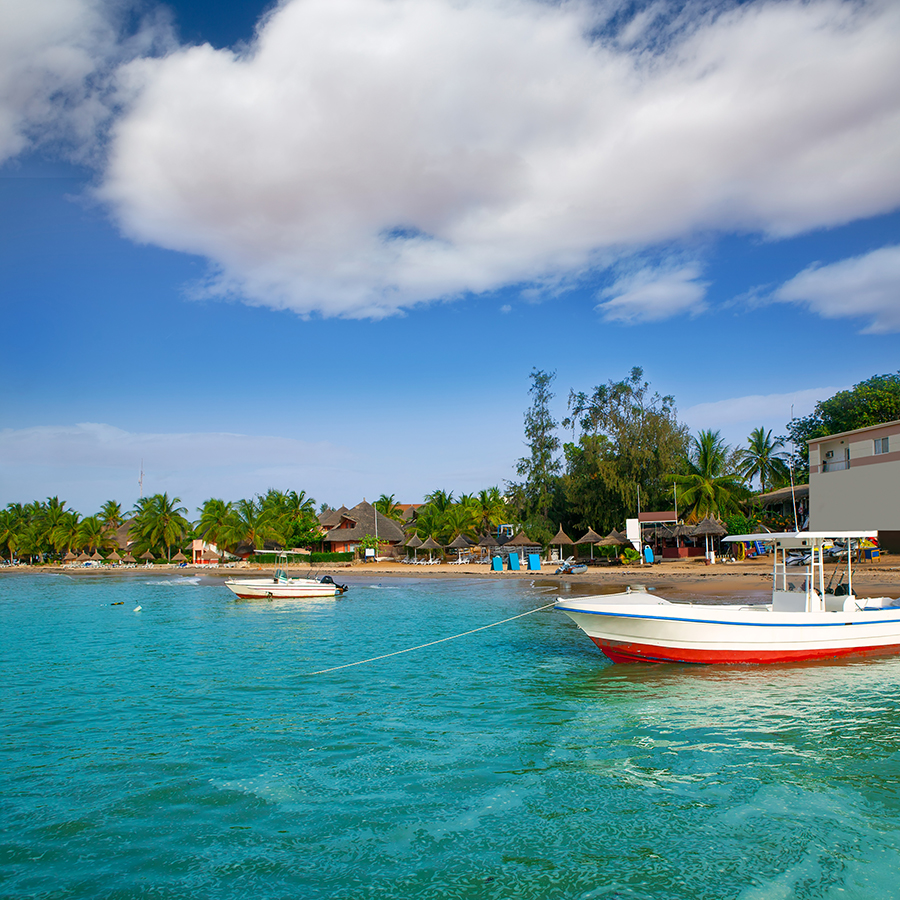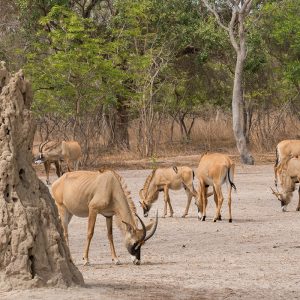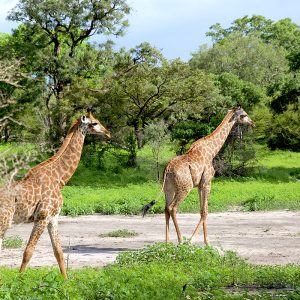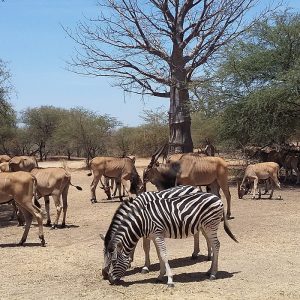Saly-Portudal, better known simply as Saly, is Senegal’s seaside tourism capital and the most famous resort in West Africa. Located just 80 km south of Dakar, the town stretches along the Petite Côte and attracts thousands of visitors each year in search of sun, turquoise waters, and Senegalese hospitality. Its origins date back to the 1980s when the government and the private sector launched a visionary project: transforming this former Serer fishing village into an international destination, built from the ground up around a protected coastline and the historic “Portudal” harbor. Today, Saly offers more than 10,000 beds spread across club hotels, private residences, and luxury villas, while retaining its local charm with fishermen, colorful markets, and a relaxed, sun-soaked lifestyle.
Seaside resort and tourist capital
of the Petite Côte
-
The Fathala safari offers an immersion into the heart of West Africa, in a vast 6,000-hectare nature reserve populated by giraffes, rhinos, ...
FathalaStarting from
103 $ / pers -
A combined safari to the Fathala Reserve and Popenguine Nature Reserve is an adventure that combines wildlife viewing, immersion in the fore...
Starting from
103 $ / pers -
A combined safari in Bandia offers the opportunity to combine wildlife viewing in a 4x4 in the reserve with other highlights of the Petite C...
BandiaStarting from
103 $ / pers
The development of Saly has not only transformed the local economy—boosting crafts, water sports, restaurants, and real estate—but has also shaped the modern identity of a village that remains attached to its roots. Between lively resorts, peaceful alleys, shaded squares, and beaches lined with casuarina trees, Saly combines modernity and authenticity. It is home to a large community of European expatriates (“Sénégaulois,” as they are known here), Senegalese families who come from Dakar on weekends, professional athletes, artists, and seasonal tourists attracted by the mild climate (an average of 82°F during the dry season), the diversity of activities, the safety, and the festive atmosphere that makes the Petite Côte so vibrant.
Saly is also the ideal starting point for exploring nearby wonders: the Somone lagoon, safaris in Bandia, excursions to Joal-Fadiouth or Popenguine, not to mention its many golf courses, spas, fitness centers, and water sports clubs. Between relaxation, adventure, encounters, and festivities, Saly embodies the best that Senegal’s seaside has to offer.

From fishing village to seaside resort
Before its tourism boom, Saly was a peaceful Serer village, where life revolved around fishing, agriculture, and crafts. The name “Portudal” comes from an old Portuguese trading post, “Porto de Ale,” which left its mark on the town’s history as early as the 16th century. The opening of the seaside resort in 1984 transformed daily life, attracting hotels, residences, shops, sports facilities, and restaurants. Despite these profound changes, Saly has maintained its roots in tradition: the daily return of the pirogues, artisan markets, village ceremonies, religious festivals, and traveling griots all serve as reminders that modernity has not erased the past.
Beaches and seaside life
The coastline of Saly stretches over 6 km, featuring fine sandy beaches protected by breakwaters, rows of coconut and casuarina trees, beach huts and bars, and a variety of shops. This policy of coastal restoration and maintenance (against erosion) has allowed Saly to remain a prime and pleasant destination year-round. The beaches are monitored, family-friendly, lively during the day, and festive in the evening. Dance classes, mini beach volleyball tournaments, night markets, and live concerts on the sand are regularly organized. It’s the perfect spot to admire the sunset over the Atlantic, cocktail in hand or enjoying a plate of grilled thiof, the iconic fish of the Senegalese coast.
Water sports in Saly
Saly is the hub for water sports along the entire Petite Côte:
- Diving & Snorkeling: certified clubs, shipwrecks, coral reefs, photo trips, and training courses.
- Boat Excursions: sport fishing, sunset cruises, trips to nearby beaches, big-game fishing for enthusiasts.
- Water Sports: windsurfing, jet-ski, paddleboarding, sea kayaking, and even kite-surfing depending on the season.
- Golf, Fitness, Horse Riding: modern facilities (18-hole golf course, tennis clubs, gyms), horseback rides on the beach or in the bush.
Excursions around Saly
Saly’s location makes it easy to explore:
- Bandia Park: family 4×4 safaris, giraffes, zebras, eagles, rhinos, monkeys, guided by naturalist guides.
- Somone (lagoon, 10 km away): explore the mangrove, pirogue rides, birdwatching, visit the lively small port at sunrise or late afternoon.
- Popenguine: cliff hikes, discover the nature reserve, Marian pilgrimage, wild swimming.
- Joal-Fadiouth: stroll on the island of shells, visit the mixed cemetery, fish market, and charming narrow streets.
-
The Fathala safari offers an immersion into the heart of West Africa, in a vast 6,000-hectare nature reserve populated by giraffes, rhinos, ...
FathalaStarting from
103 $ / pers -
A combined safari to the Fathala Reserve and Popenguine Nature Reserve is an adventure that combines wildlife viewing, immersion in the fore...
Starting from
103 $ / pers -
A combined safari in Bandia offers the opportunity to combine wildlife viewing in a 4x4 in the reserve with other highlights of the Petite C...
BandiaStarting from
103 $ / pers
Crafts and local life
In Saly, the artisan market is one of the richest in the country: batiks in a thousand colors, ebony figurines, carved masks, Tuareg jewelry, woven baskets, and wooden instruments. Many workshops offer demonstrations and introduce visitors to making an item—perfect for bringing home a personalized souvenir.
The fishing port is an open-air theater: every morning, the painted pirogues return, welcomed by a dance of vendors, restaurateurs, and children, amidst the aroma of grilled fish and patchouli.
What makes Saly unique
- Intensive water sports & sports clubs: the variety and choice are unbeatable along the Coast.
- Easy safari: Bandia in 20 minutes: giraffes, zebras, rhinos, buffaloes.
- Nightlife: bars, markets, restaurants, nightclubs, and beach performances.
- Ideal starting point: everything is nearby, whether it’s nature, culture, adventure, or relaxation.
- Cultural diversity: a wide variety of residents and visitors (Europeans, Dakar locals, African families, athletes from around the world).
- Local life: lively market, bustling craft scene, and a fishing port that still operates “the old-fashioned way.”li>

Anecdotes from Saly
- Some villas in Saly are built around century-old baobabs declared “untouchable” by local legend: it is said that touching them brings prosperity – or the visit of a mischievous monkey.
- When the pirogues return, it’s not uncommon for the fishermen to hold “shouting contests” on the beach: the loudest wins a fish, sometimes given to a child who knows the latest hit by Wally Seck.
- When the pirogues return, it’s not uncommon for the fishermen to hold “shouting contests” on the beach: the loudest wins a fish, sometimes given to a child who knows the latest hit by Wally Seck.
Anecdotes from Saly
FAQ
Yes, Saly offers supervised beaches, a variety of activities, and a safe environment suitable for families.
Yes, Saly offers diving and snorkeling with certified clubs, coral reefs, and shipwrecks to explore.
Saly is a large, lively seaside resort with beaches, hotels, water sports, and nightlife, while Somone is quieter, centered around the lagoon, mangroves, and bird watching.
Three to five days allow you to enjoy the beaches, nature excursions, and local activities without rushing.
The best time to visit Saly is from November to May, during the dry season.
To observe local life in Saly, visit the craft market, the fishing port when the pirogues return, and the surrounding villages such as Somone or Joal-Fadiouth.


